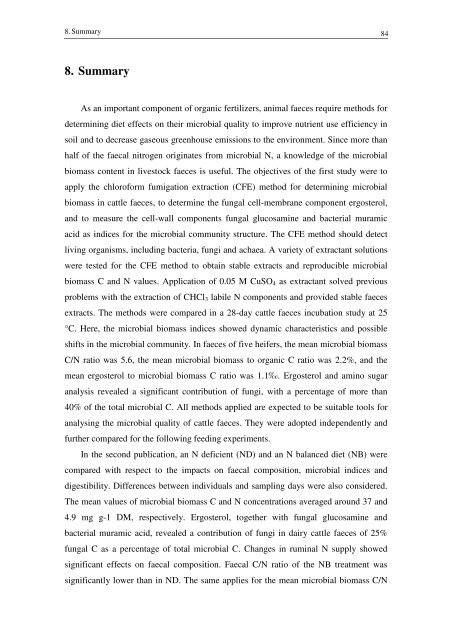Fütterungsbedingte mikrobielle Zusammensetzung von Rinderkot ...
Fütterungsbedingte mikrobielle Zusammensetzung von Rinderkot ...
Fütterungsbedingte mikrobielle Zusammensetzung von Rinderkot ...
Create successful ePaper yourself
Turn your PDF publications into a flip-book with our unique Google optimized e-Paper software.
8. Summary 84<br />
8. Summary<br />
As an important component of organic fertilizers, animal faeces require methods for<br />
determining diet effects on their microbial quality to improve nutrient use efficiency in<br />
soil and to decrease gaseous greenhouse emissions to the environment. Since more than<br />
half of the faecal nitrogen originates from microbial N, a knowledge of the microbial<br />
biomass content in livestock faeces is useful. The objectives of the first study were to<br />
apply the chloroform fumigation extraction (CFE) method for determining microbial<br />
biomass in cattle faeces, to determine the fungal cell-membrane component ergosterol,<br />
and to measure the cell-wall components fungal glucosamine and bacterial muramic<br />
acid as indices for the microbial community structure. The CFE method should detect<br />
living organisms, including bacteria, fungi and achaea. A variety of extractant solutions<br />
were tested for the CFE method to obtain stable extracts and reproducible microbial<br />
biomass C and N values. Application of 0.05 M CuSO4 as extractant solved previous<br />
problems with the extraction of CHCl3 labile N components and provided stable faeces<br />
extracts. The methods were compared in a 28-day cattle faeces incubation study at 25<br />
°C. Here, the microbial biomass indices showed dynamic characteristics and possible<br />
shifts in the microbial community. In faeces of five heifers, the mean microbial biomass<br />
C/N ratio was 5.6, the mean microbial biomass to organic C ratio was 2.2%, and the<br />
mean ergosterol to microbial biomass C ratio was 1.1‰. Ergosterol and amino sugar<br />
analysis revealed a significant contribution of fungi, with a percentage of more than<br />
40% of the total microbial C. All methods applied are expected to be suitable tools for<br />
analysing the microbial quality of cattle faeces. They were adopted independently and<br />
further compared for the following feeding experiments.<br />
In the second publication, an N deficient (ND) and an N balanced diet (NB) were<br />
compared with respect to the impacts on faecal composition, microbial indices and<br />
digestibility. Differences between individuals and sampling days were also considered.<br />
The mean values of microbial biomass C and N concentrations averaged around 37 and<br />
4.9 mg g-1 DM, respectively. Ergosterol, together with fungal glucosamine and<br />
bacterial muramic acid, revealed a contribution of fungi in dairy cattle faeces of 25%<br />
fungal C as a percentage of total microbial C. Changes in ruminal N supply showed<br />
significant effects on faecal composition. Faecal C/N ratio of the NB treatment was<br />
significantly lower than in ND. The same applies for the mean microbial biomass C/N
















